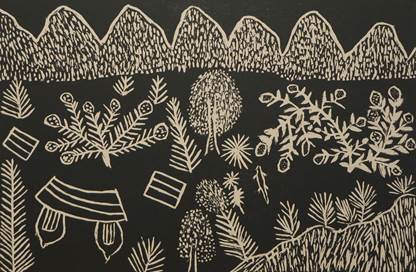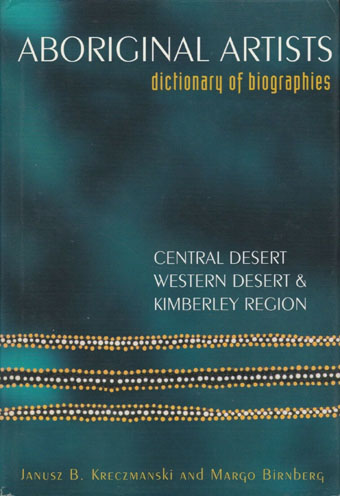|
Gloria
Petyarre Mills
Biography:

Gloria Mills Petyarre
(also
known as Glory)
is a
renown
Australia's
Contemporary
abstract
artist,
highly
valued
in the
World Art
Market.
Glory Mills Petyarre
participated in the
Utopia A Picture Story.
Gloria (Glory) Mills Petyarre
work is held in
Australian
and international
collections around the
world.
Glory
Mills beautiful
paintings,
capture the multi-dimensional presence
of
space and depth,
have
the sheer
physical presence of the much contemporary
the state-of-art work.
Glory's father
(Alhalkere Jack) is brother to
Emily
Kngwarreye.
Glory Mills
brother is
Greeny Purvis Petyarre
(1930-2010).
Glory
family
also include
Lindsay Bird,
Gloria Petyarre
and
Anna Petyarre.
Glory Mills Petyarre was born around 1932 at Boundary Bore
Outstation in the Utopia Region, north east of Alice Springs. Her language group
is Anmatyerre
Gloria (Glory) Mills Petyarre and Dolly
Mills Petyarre (born 1934) are full sisters to
Greeny
Purvis Petyarre
(1930-2010).
Glory and Dolly Mills sisters were born at
Boundary Bore Outstation in the Utopia Region, north east of Alice Springs.
Glory Mills Petyarre is widely recognized
as one of Australia's leading Aboriginal artists.
Glory's father
(Alhalkere Jack) is
Emily
Kngwarreye
brother.
Glory Mills
family
include
Lindsay Bird,
Gloria Petyarre
and
Anna Petyarre.
Glory Mills
Petyarre
work can be seen in major Australian and
international
collections
including
Charles Darwin University,
Museum Dorestad Holland,
Kelton Foundation Santa Monica
USA,
University Art Museums Australia,
Portland Art Museum USA,
Art Gallery of South Australia,
Utopia A Picture Story,
Museum Art Gallery
of the Northern Territory,
Queensland Art Gallery.
Glory
Mills
Petyarre
paintings
have
the sheer
physical presence of the much contemporary work of fine art.
Her beautiful
state-of-art
work
capture the multi-dimensional presence
of
space and depth.
Gloria (Glory) Mills Petyarre
work can be seen in major Australian and international
collections. Glory, like many of the women from Utopia started with silk
batik in the early 80's. Both sisters participated in the book "Utopia -
A Picture Story", which included 88 silk batiks from the Robert Holmes a
Court Collection. This book helped to confirm the artistic credibility
of the artists living in the Utopia region of Australia. Her main
painting subjects are Yam Dreaming and Bush Tobacco.
The patterning and vibrant colour of Glory Mills Petyarre's work depicts
her native country of Alhalkere in the Utopia's region north east of
Alice Springs and her most important subject matter is of the "Yam
Dreamings". The Yam is one of the most stable types of bush tucker
gathered in the region of Utopia. The yam has a complex root system that
can spread up to twelve metres from its stalk. The plant has bright
green leaves with yellow flowers and branches out over a wide area. It
is commonly found in woodland areas and close to a water source.
Related Work
COLLECTIONS
Charles Darwin University Collection

Gloria [Glory] Mills Petyarre
(1932-2018)
Untitled 1990,
Wood block print on paper, edition 9/20,
30 x 45cm,
Australian Government’s Cultural Program
CDU Art Collection -
CDU2818
Art Gallery of South Australia
Charles Darwin University
-
University Art Museums Australia (UAMA)
Museum Dorestad, The Netherlands
The S.H. Ervin Gallery
OHSU Heart Research Centre
Portland Art Museum, USA
Umpqua Bank,
Portland USA
Cove Street Gallery Portland, Oregon USA
Kelton Foundation Santa Monica USA
Art Bank Sydney
Art Gallery of Western Australia
National Gallery of
Victoria
Queensland Art Gallery
Museum and Art Gallery
of the Northern Territory
Holms a Court gallery
collection
EXHIBITIONS
1984
The First National Aboriginal Art Award Exhibition, Museum and Art
Gallery of the Northern Territory, Darwin.
1985
The Second National Aboriginal Art Award Exhibition, Museum and
Art Gallery of the Northern Territioy, Darwin.
1989
Utopia Women’s Paintings, the First Works on Canvas, A Summer
Project
1988-89
The S.H. Ervin Gallery
1990
A picture Story
Utopia
88 Silk works,
Holmes a Court
gallery toured Eire and Scotland.
1992
Central Australian Aboriginal Art and Craft Exhibition, Araluen
Centre, Alice Springs
1998
Dreamings, Vlaams-Europeesch Conferentiecentrum Brussels,
Belgium
1998
Museum Dorestad, The Netherlands, Wijk bij Duursede
2000 Mbantua gallery, Alice Springs, NT
2002
Celestial Light,
Redback Art Gallery, Queensland
2002 Mbantua Gallery - Art and Soul Gallery, Nashville, T.N, U.S.A
2002
Cove Street Gallery Portland, Oregon USA
2002 Mbantua Gallery - Urban Wine Works, Portland, Oregon USA
(Benefit –
OHSU Heart Research Centre)
2002 Mary's Woods, Portland, Oregon USA (Benefit –
OHSU Heart Research Centre)
2003 Mbantua Gallery - New City Merchants, Knoxville, T.N USA
2003 Mbantua Gallery - Art and Soul Gallery, Nashville, T.N USA
2003
Cove Street Gallery Portland, Oregon USA
2003 Contemporary Aboriginal Art Event,
Umpqua Bank,
Portland, USA
2003 Mbantua Gallery - Mary's Woods, Portland Oregon USA
2004 Art From The Dreamtime,
Portland Art Museum, USA
2004
Aug-Sep
Mbantua
-
Nashville and Hartford Gallery USA
2005
March
Yam Dreaming – Atnwelarre, Mbantua Gallery, Alice Springs, NT
Gloria (Glory)
Mills Petyarre
Rainbow series
Australian
artist
Gloria
Mills Petyarre 'Rainbow
Serpent' paintings
are
vibrant and inspiring, she
depicts her native country of Alhalkere (Utopia's region north east of Alice
Springs) and her
paintings have contemporary (the present-day) expression.
Gloria
Mills beautiful
painting capture the multi-dimensional presence of
space and depth, have
the
physical presence of the much contemporary work
of art.
Gloria Mills
painted the Dreamings that belong to her country.
Subjects:
Pencil Yam Seed, Emu Tucker,
Bush Flowers, Pencil Yam, Wild
Tobacco, Country, Awelye (Women’s Ceremony and Body Paint
Designs.
When the 'Rainbow' is seen in the sky, it is said to be the ‘Rainbow
Serpent’ moving from one waterhole to another, and the divine concept
explained why some waterholes never dried up when drought struck.
The ‘Rainbow Serpent’ or ‘Rainbow Snake’ is a common ‘holy being’, often a
creator god in the
mythology and a common
motif in the art of Aboriginal
Australia. It is named for the
obvious identification between the shape of a rainbow and in the shape of a
snake.
There are innumerable names and stories associated with the serpent, all of
which communicate the significance and
power of this being within Aboriginal
traditions. It is viewed as a giver of life, through its association with
water, but can be a destructive force if angry. The Rainbow Serpent is one
of the oldest continuing religious beliefs in the world.
Some scholars have suggested that the link between snake and rainbow
suggests the cycle of the seasons and the importance of water in human life.
Literature
Source
& FURTHER
REFERENCES

Australian Aboriginal Artist dictionary of biographies
Kreczmanski, Janusz B and Birnberg, Margo (eds.): Aboriginal Artists:
Dictionary of Biographies: Central Desert, Western Desert and Kimberley
Region JB Publishing Australia, Marleston, 2004.
Aboriginal Artists of the Western Desert - A Biographical Dictionary by
Vivien Johnson, published by Craftsman House 1994
The Oxford Companion to Aboriginal Art and Culture edited by Sylvia
Kleinert and Margo Neale published by OUP 2000
Aboriginal Artists: Dictionary of Biographies: Central Desert, Western
Desert & Kimberley Region JB Publishing Australia, Marleston, 2004
Brody, A. 1989 Utopia women’s Paintings: the First Works on Canvas, A
summer Project, 1988-89 exhib. Cat. Heytesbury Holdings, Perth Brody
A. 1990 Utopia, a picture Story, 88 Silk Batiks from the Robert Homes a
Court Gallery and gallery Collection, Heytesbury Holdings
LTD Perth NATSIVAD database, Latz, P. 1995, Bushfires & Bushtucker, IAD
Press, Alice Springs
Brody, A. 1989 Utopia women’s Paintings: the First Works on Canvas, A
summer Project 1988-89 exhib. Cat. Heytesbury Holdings, Perth Brody
Amadio, N. und Kimber, R., Wildbird Dreaming. Aboriginal Art from the
Central Deserts of Australia, Greenhouse Publ., Melbourne 1988; Auckland
City Art Gallery, Auckland 1990, Ausst. Kat.; Australian Aboriginal Art
from the Collection of Donald Kahn. Lowe Art Museum, University of Miami
(Hrsg.), 1991, Ausst. Kat.; Droombeelden - Tjukurrpa. Groninger Museum (Hrsg.),
Groningen 1995, Ausst. Kat.; Isaacs, J., Australia´s Living Heritage.
Arts of the Dreaming, Lansdowne Press, Sydney 1984; Isaacs, J.,
Australian Aboriginal Paintings. Lansdowne, Sydney 1989, ISBN
186302011X; Johnson, V., Aboriginal Artists of the Western Desert. A
Biographical Dictionary, Craftsman House, East Roseville 1994, ISBN
9768097817; Modern Art - Ancient Icon. The Aboriginal Gallery of
Dreamings (Hrsg.), o.O. 1992, ISBN 0646080520; Nangara. The Australian
Aboriginal Art Exhibition from the Ebes Collection. The Aboriginal
Gallery of Dreamings (Hrsg.), Melbourne 1996, Ausst. Kat.; Stourton, P.
Corbally, Songlines and Dreamings. Lund Humphries Publ., London 1996,
ISBN 0853316910; The Painted Dream. Contemporary Aboriginal Paintings.
Johnson, V. (Hrsg.), Auckland City Art Gallery, Auckland 1991, Ausst.
Kat.; Tjinytjilpa. The Dotted Design. Aboriginal Art Galleries of
Australia (Hrsg.), Melbourne 1998, Ausst. Kat.; Traumzeit - Tjukurrpa.
Kunst der Aborigines der Western Desert. Die Donald Kahn-Sammlung,
Danzker, J.B. (Hrsg.), Prestel, München und New York 1994, Ausst. Kat.;
Voices of the Earth. Paintings, Photography and Sculpture from
Aboriginal Australia. Gabrielle Pizzi (Hrsg.), Gallery Gabrielle Pizzi,
Melbourne 1996, Ausst. Kat., ISBN 0646288954.
RETURN TOP |